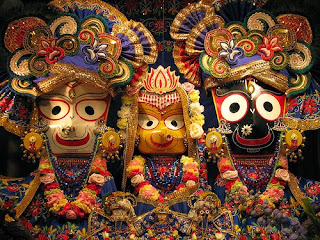Khandua Ikat, which is primarily woven in Nuapatna in the Cuttack district of Orissa, is associated with Lord Jagannath, the Lord of the universe, for whom it was initially woven possibly as early as the 11
th century. This is believed to have been upon the orders of a king named Gajapati who is said to have paid weavers with land. Legend also has it that, in the 12
th century, a poet named Jaidev wanted to offer the Gita Govinda to the Lord, and chose to have its verses woven into silk using Khandua Ikat to accomplish this.
More recently, in the 18
th century, Ramachandra, the ruler of Puri is believed to have revived the practice of having Khandua Ikat woven for Lord Jagannath and His siblings Lord Balabhadra and Devi Subhadra. With the passage of time, products woven in Khandua Ikat have diversified considerably and now include sarees. The tying and dying of Khandua Ikat is, however, still executed by men alone supposedly to ensure that the fabric remains pure and sacred. The colours used on Khandua Ikat sarees are usually dark, and the motifs (which generally feature flora and fauna) are rounded with no sharp corners or edges. The outlines of the motifs are not sharp either; they appear as though colour has bled.
 |
| Dyed warp of the border of a Nuapatna Khandua Ikat Saree |
The sarees are woven in silk, cotton and tassar; they tend to be single Ikat sarees with the patterns on the bodies of the sarees being dyed along the weft before they are woven. The borders and end-pieces of Khandua Ikat sarees are treated differently: parts of the end-piece may be dyed with a brush instead of being tied and then dyed. And the borders of Khandua Ikat sarees tend to feature designs which have been dyed along the warp instead of the weft, and have some designs, often 'rudraksh' (as seen in the picture), woven in with supplementary threads. Both the borders and end-pieces of Khandua Ikat sarees tend to be in a colour which contrasts with the colour of the main body of the saree. Also, apart from being dyed with patterns, the body of a Khandua Ikat saree may be plain or contain butis.

